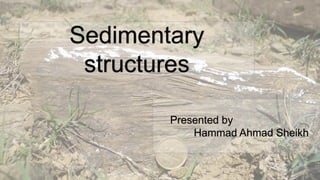
Sedimentary structures Present in Permian and Eocene Rocks of Pakistan
- 2. • Sedimentary structures are large scale features of the sedimentary rocks and include the familiar cross bedding ripple marks, bioturbation, bedding unit etc.
- 3. Depositional Structures Lamination • Lamination develops in fine grained sediment when fine grained particles settle, which can only happen in quiet water. Bedding • Bedding is produced by changes in the pattern of sedimentation i.e. defined by changes in sediment grain size, color and mineralogy. Fig 1.1 showing lamination in the Dandot Formation Fig 1.2 showing Massive bedding in the Tobra Formaton
- 4. Depositional structures Graded Bedding Normal graded bedding developed where the coarsest particle at the base give way to finer particles higher up. Inverse graded Bedding Reverse grading can arise from an increasing strength of flow during sedimentation but more commonly from grain dispersion. Fig 1.3 showing Normal Graded Bedding in the Tobra formation. Fig 1.4 showing Inverse graded Bedding in the Tobra Formation.
- 5. Hummocky Cross stratification Hummocky Cross Stratification is characterized by a gently undulating low angle (<10-15) cross lamination with the convex- upward part the hummock and concave-downward part the swale. Fig 1.5 showing Hummocky Cross stratification in the Dandot Formation. Depositional Environment
- 6. Depositional structures Trough Cross Bedding Trough cross bedding is formed in result of erosion and deposition related to ripple and dune migration. Ripple Cross Lamination It is form in the result of migration of asymmetrical Ripples in downcutting direction. Fig 1.6 showing Trough Cross Bedding in the Dandot Formation. Fig 1.7 showing Ripple Cross Lamination in the Dandot Formation.
- 7. Depositional structures Flaser bedding is formed where mud deposition is intermittent with ripple migration, thin streaks of mud occur between sand. Flaser bedding is the characteristic feature of the inter- tidal zone. Flaser Bedding Fig 1.8 showing Flaser Bedding in the Dandot Formation.
- 8. Wavy Bedding When there is an equal proportion of sand and mud deposited then wavy bedding is formed. Wavy Bedding is the characteristic feature of the mixed flat in the inter-tidal zone. Depositional structures Fig 1.9 showing wavy bedding in the Dandot Formation.
- 9. Lenticular Bedding Lenticular bedding is the term applied to isolated ripples of sand within the mud as lenses. Depositional structures Fig 1.10 showing Lenticular bedding in the Dandot Formation.
- 10. Depositional structures Asymmetrical Ripple Marks Current Ripples are produced by unidirectional currents so they are asymmetrical with a steep leeside(downstream) and gentle stoss- side(upstream). Ripple Marks Fig 1.11 showing Asymmeterical Ripple Marks in the Dandot formation.
- 11. Depositional structures Symmetrical Ripple Marks Under natural conditions they form by river and stream flow, by backwash on beaches, and by longshore currents, tidal currents, and deep-ocean bottom currents. Ripple Marks Fig 1.12 showing symmetrical Ripple Marks in the Dandot Formation.
- 12. Erosional structures The presence of iron nodules mainly composed of hematite in claystone indicates that these nodules were formed in poorly to moderately drained substrates, probably in fluvial floodplain environments. Clay nodules Fig 1.13 showing clay nodules in the Erosional structures.
- 13. Channels Channels are formed by erosion, principally by currents but in some cases by mass movements. Channels developed in many environments like in fluvatile, glacial , deltaic, tidal-flat, shelf-margin and slope marine fan locations. Erosional Structures Fig 1.14 showing Channels in the Erosional structures.
- 14. Rain imprints Rainspots are small depressions with rims formed through the impact of rain on the soft exposed surface of fine grained sediment. Post-Depositional structures Fig 1.15 showing Rain imprints in the Dandot Formation.
- 15. Load Cast Load structures are formed through differential sinking of one bed into another. Load casts have been reported in deposits from a variety of environments, including fluvial, lacustrine, deltaic, and shallow-marine. Post-Depositional structures Fig 1.16 showing Load cast in the Dandot Formation
- 16. Bioturbation is produced by a variety of organisms and because different organism engage in similar types of behavior. Biogenic structures Bioturbation Fig 1.17 showing Bioturbation in the Tobra Formation. Fig 1.18 showing bioturbation in the Dandot Formation.
- 17. Biogenic structures Bioturbation Fig 1.19 & 1.20 showing Bioturbation in the Tobra Formation.
- 18. Trace Fossils Tracks, trails, burrows, borings, and other structures made by organisms on bedding surfaces or within beds are known collectively as trace fossils. Biogenic structures Fig 1.21 showing Trace Fossils in the Dandot formation
- 19. Biogenic structures • Petrified wood forms when plant debris is buried by sediment and then replaced by deposition of mineral material dissolved in groundwater. Fig 1.22 showing Petrified Wood in the Dandot Formation. Petrified Wood
- 20. Biogenic structures Petrified Wood Fig 1.23 showing Petrified Wood in the Dandot Formation.
